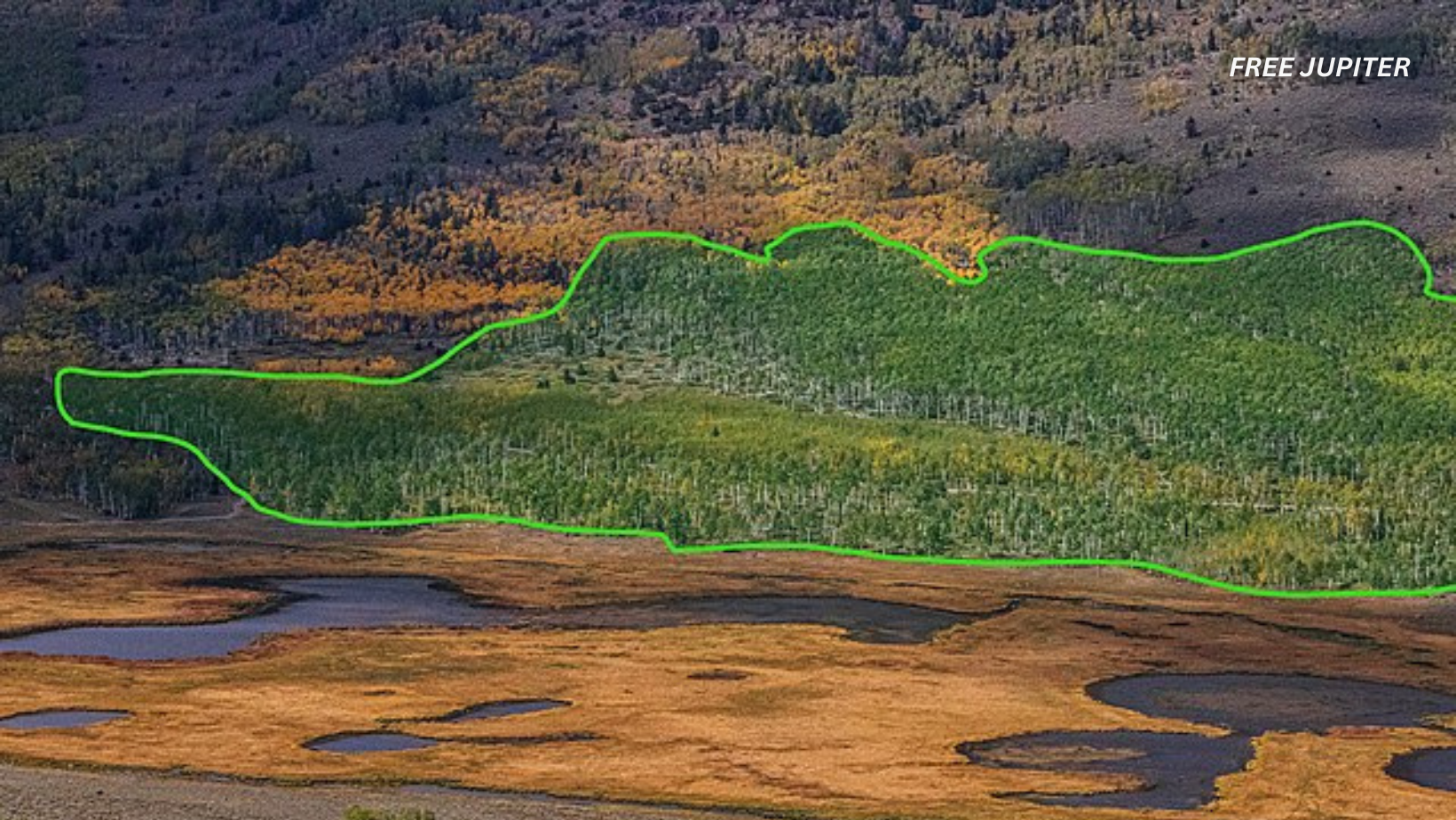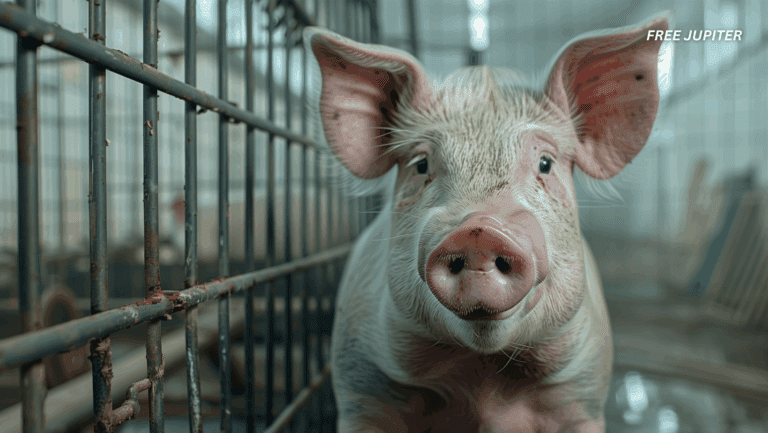Friendly Note: FreeJupiter.com shares general info for curious minds 🌟 Please fact-check all claims—and always check health matters with a professional 💙
In the rugged Wasatch Mountains of Utah, perched above a serene spring-fed lake, there exists an extraordinary living marvel that quietly supports a vibrant ecosystem—an immense organism known as Pando. Unlike a typical forest, Pando is a single genetic entity, a vast colony of quaking aspens that collectively form what is recognized as the largest organism on the planet by mass.
Pando: A Living Giant Spanning Over 100 Acres
Pando spans approximately 106 acres, composed of nearly 47,000 individual aspen stems that are genetically identical, all interconnected through a shared root system. This interconnectedness means that what appears to be a forest of separate trees is, in fact, one colossal organism. The name “Pando,” derived from Latin meaning “I spread,” aptly describes this sprawling natural wonder. Weighing in at around 6,000 metric tons, it dwarfs any other known single living entity on Earth.
While clonal aspen groves are not uncommon across North America, Pando’s sheer scale is exceptional. Most similar stands in the western United States cover only a few acres, making Pando’s expanse truly remarkable. Its age is equally impressive; estimates suggest it has thrived for up to 14,000 years. This longevity is particularly notable given that individual aspen stems typically live about 130 years before dying and being replaced by new growth sprouting from the root network.
An Ecosystem Built on One Organism
This ancient organism supports a rich and diverse ecosystem. Under its canopy, 68 species of plants flourish alongside numerous animals, all dependent on the health and vitality of Pando’s aspen stems. The ecosystem’s balance hinges on the continual regeneration of new stems, ensuring the organism’s survival and the habitat it provides.
The dappled shade created by Pando’s dense canopy fosters a unique microenvironment where wildflowers bloom and pollinators thrive. Birds, foxes, beavers, and deer all find shelter and sustenance within this living fortress. The interconnected root system not only sustains the trees but also stabilizes the soil, preventing erosion and maintaining water quality in the nearby lake.
Threats From Within: The Impact of Overgrazing
However, Pando faces significant challenges that threaten its future. One of the most pressing concerns is the impact of overgrazing by deer and elk. Historically, predators such as wolves and cougars kept these herbivore populations in check, but their decline has led to larger herds. These animals find refuge within Pando’s protective woodland, where hunting pressures are minimal.
As mature trees die and fall, sunlight reaches the forest floor, encouraging new stems to emerge. Unfortunately, these young shoots are often browsed by deer and elk before they can mature, effectively halting regeneration across much of Pando. The result is a landscape where older stems dominate, but new growth is scarce, jeopardizing the organism’s long-term survival.
There is a silver lining: a section of Pando fenced off several decades ago to exclude deer and elk has seen a flourishing of new stems, creating a dense thicket affectionately called the “bamboo garden.” This area demonstrates that, with protection from grazing, Pando can regenerate successfully.
Disease and Decline: The Silent Struggles
In addition to herbivory, Pando is contending with several diseases affecting its older stems, including sooty bark canker, leaf spot, and conk fungal disease. While these ailments have long been part of aspen ecology, the combination of disease pressures with limited new growth raises concerns about the organism’s resilience.
These diseases weaken the structural integrity of the trees and reduce their ability to photosynthesize efficiently, compounding the stress from grazing and environmental changes. The cumulative effect threatens to accelerate the decline of Pando’s older stems, making the regeneration of new growth even more critical.
Climate Change: An Unprecedented Challenge
Perhaps the most formidable challenge comes from climate change. Pando emerged after the last ice age and has thrived in a relatively stable climate since. Although it naturally endures alpine conditions surrounded by desert, the rapid shifts in temperature and precipitation patterns pose unprecedented stress.
Aspens are sensitive to changes in water availability and temperature. Warmer springs and reduced water supply hinder the trees’ ability to produce new leaves, which can lead to declines in overall coverage. Pando’s root system does not reach the nearby Fish Lake, limiting its access to water during droughts. Coupled with projections of hotter summers and more intense wildfires, these factors threaten both Pando’s size and the ecosystem it supports.
Wildfires, while a natural part of many forest ecosystems, pose a complex threat to Pando. Fire can stimulate new growth by clearing underbrush, but increasingly severe and frequent fires driven by climate change may overwhelm the organism’s ability to recover. The balance between destruction and regeneration is delicate and increasingly precarious.
Conservation Efforts and Scientific Research
Despite these challenges, Pando’s history is one of resilience. It has withstood environmental changes brought by human settlement in the 19th century and recreational activities in the 20th century. It remains the largest scientifically documented organism on Earth, a testament to its enduring strength.
Scientists and conservationists are actively studying Pando to better understand its biology and vulnerabilities. Research focuses on how to manage grazing pressures, combat diseases, and help the organism adapt to climate change. The US Forest Service, along with conservation groups like Friends of Pando, are spearheading efforts to protect this natural treasure.
Friends of Pando, in particular, is working to raise public awareness and foster a connection between people and this remarkable organism through innovative tools such as 360-degree video tours. These virtual experiences allow people worldwide to explore Pando’s unique environment without disturbing its fragile ecosystem.
A Personal Encounter with Nature’s Giant
Visiting Pando offers a unique experience. Walking beneath towering aspens that shimmer in the breeze, exploring the dense bamboo garden, and wandering through wildflower-strewn meadows reveals a thriving, interconnected world. The presence of pollinators, birds, foxes, beavers, and deer highlights the intricate web of life sustained by this single organism.
Such encounters underscore the profound importance of protecting not just individual species but entire ecosystems. Pando’s survival depends on a delicate balance of factors, from herbivore management to disease control and climate adaptation. Protecting Pando means safeguarding a living legacy that supports countless forms of life and offers insights into resilience and interconnectedness in nature.
The Future of Pando: A Living Legacy Worth Preserving
In essence, Pando is more than a forest; it is a living giant, a silent guardian of biodiversity that has endured millennia. Its story underscores the need for thoughtful stewardship of our natural world, ensuring that this remarkable organism continues to thrive for generations to come.
The challenges are formidable, but with continued research, conservation, and public engagement, there is hope that Pando will persist. It stands as a symbol of nature’s endurance and the intricate connections that bind life on Earth—an extraordinary organism that invites us to appreciate and protect the delicate balance of our planet’s ecosystems.










